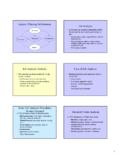Transcription of Job Evaluation Guidelines - World Health Organization
1 Job Evaluation Guidelines 2 All rights, including translation into other languages, reserved. No part of this publication may be reproduced in print, by photostatic means or in any other manner, or stored in a retrieval system, or transmitted in any form, or sold without the express written permission of the International Council of Nurses. Short excerpts (under 300 words) may be reproduced without authorisation, on condition that the source is indicated. Copyright 2010 by ICN - International Council of Nurses, 3, place Jean-Marteau, CH-1201 Geneva (Switzerland) ISBN: 978-92-95094-16-1 Printing: 3 Table of Contents Introduction 5 Definition and Importance of Job Evaluation 7 Steps in the Job Evaluation Process 8 Avoiding gender bias 9 Job Evaluation Methods 10 Ranking method 10 Classification method 11 Factor comparison method 12 Point-rating method 13 Definition of Remuneration Factors for Nursing 16 Equal Remuneration and Job Evaluation 18 International Classification of Nursing 19 Taxonomy for Job Evaluation 20 National Nurses Association Role in Job Evaluation 21 Conclusion 23 References 24 Appendices Appendix I: Job Evaluation Questionnaire 25 Appendix II: job description for Nurses 32 Appendix III.
2 Factors Definition 34 4 5 Introduction "Never doubt that a small group of thoughtful, concerned citizens can change the World . Indeed it is the only thing that ever has." Margaret Mead Nurses have a right to practice in an environment that is conducive to quality care; to expect competitive wages/benefits and to work in a family-friendly environment that promotes the occupational safety and Health of its employees..The work of nursing personnel and its importance for the life, personal safety and Health of persons in their care demands measures that encourage and promote the full development and implementation of negotiating mechanisms between employers, nurses and their representatives..The principles of equal pay for work of comparable value and pay equity should be applied. These principles should be supported by gender-neutral job classification and performance Evaluation tools, and non-discriminatory access to education and promotion opportunities.
3 ICN Position Statement1 Although remuneration has not traditionally been a factor in attracting people to the profession of nursing, there is no doubt that financial considerations increasingly influence the recruitment and retention of nurses worldwide. For a new generation of nurses, wages represent a primary consideration as they determine the direction of their professional lives. Retaining nurses is increasingly dependant on the ability to offer them competitive salaries. Findings from the annual ICN Nurses Wage Survey repeatedly highlight that nurses are by and large paid less for their work than professionals in comparable occupations, such as physicians, physiotherapists, teachers and accountants. Nurses are in high demand and universally short in supply. Despite this, salaries and working conditions often remain unattractive, and more importantly, uncompetitive.
4 Research indicates that many nurses are underpaid because job-related skills are not treated as professional assets but as qualities intrinsic to being a Forty years after the Equal Pay Act men still earn, on average, 22 percent an hour more than women in the UK.*3 According to the Census Bureau female physicians wages average 63 cents for every dollar earned by their male A recent study conducted by researchers at Carnegie Mellon University examines women s negotiating skills and found that women of all ages are less likely to initiate salary negotiation and more likely to accept what their employer or prospective employer When job Evaluation systems are gender-biased and fail to capture or value the work of nurses and other women workers, this perpetuates existing wage inequities.
5 It is important that the nursing profession, dominated by women, define the nature of its work and assist in the development of relevant Evaluation tools that are objective, transparent, and non-discriminatory. The profession should not tolerate complacency about the lack of equitable rewards for women and must hold leadership accountable for redressing unconscionable gender differences in salary. As witnessed by the nursing profession, the pay gap between men and women workers will not disappear through educational achievement or qualifications alone. The social * There are a number of different ways of calculating the gender pay gap. The UK Government s preferred measure compares the pay of all men and women in work (full- and part-time) and looks at the median.
6 By this measure, the gender pay gap is per cent. 6 partners, including national nurses associations and professional unions, must urgently undertake a systematic reform of cultural attitudes, employment policies and institutional structures that perpetuate direct and indirect discriminatory practices against This monograph is prepared to draw nurses attention to job Evaluation planning. It is designed to give good practice guidance to evaluators in the field on how to formulate, implement and measure job Evaluation plans. The objectives of this monograph are to: Provide nurses and national nurses associations (NNAs) with information on the definition and importance of job Evaluation . Describe the steps in a job Evaluation process. Define remuneration and discuss the importance of equality for nurses when developing a job Evaluation plan.
7 Identify the potential roles of the NNAs in the ongoing development of job Evaluation planning. Provide guidance to practitioners in organisations on how to formulate, implement and maintain job Evaluation plans which are free of sex bias. 7 Definition and Importance of Job Evaluation Job Evaluation is a technique to provide a systematic, rational, and consistent approach to defining the relative worth of jobs within an organisation. This process is based on the assessment of the relative importance of the tasks involved. It is not concerned with the volume of work, or with the person doing it, or with determining pay. It is used in order to provide the basis for an equitable and defensible pay structure, particularly in determining equal pay for work of equal or comparable Through its focus on the nature of jobs, job Evaluation provides a practical means of implementing this principle.
8 It also offers a convenient method for revealing discriminatory practices in any organisation before a complaint is It is important to note that job Evaluation is not performance Evaluation . Job Evaluation determines the relative value of a job to the organisation while performance Evaluation determines the relative value of an individual / employee to the organisation. It is the job that is being evaluated, not the person who is doing that This process assesses the qualitative aspects of the job, not the quantitative aspects. In other words, it is not the amount of work allocated to a job which is primarily measured, but its relative demands, complexity and responsibility and the competency required to carry out the job The technique of job Evaluation has developed largely as a response to various pay administration problems encountered in large-scale modern enterprises.
9 With large numbers of workers being employed, clear rules for payment are essential if labour costs are to be accurately estimated and controlled and meaningful personnel policies to be followed. Therefore, an objective, transparent and systematic way of calculating the worth of jobs must be mutually agreed upon between employers and employees. A systematic job Evaluation is an aid to reveal the values that consciously or unconsciously discriminate against female Those in charge of an organisation often consider an analysis of the job Evaluation process for the following reasons:12 Determining pay and grading structures Ensuring a fair and equal pay system Deciding on benefits provision, bonuses Comparing pay rates against the external market Undergoing organisational development in times of change Undertaking career management and succession planning Reviewing all jobs post-large scale changes, especially if roles have also changed.
10 Job Evaluation develops a means of providing competence-based pay progression, an approach that would bring equity to those working in an organisation and, importantly, offer a means to support lifelong learning and career progression. Therefore, government, employers and workers should all recognise that an effective job Evaluation plan offers a reliable and valid tool to review jobs and their inherent worth in terms of salaries and benefits for competent individuals. 8 Steps in the Job Evaluation Process There are many variations of job Evaluation methods. Some are more complicated than others. The choice of an Evaluation method is important and will depend on the number and type of jobs to be evaluated and available resources. However, they all basically follow the same approach, which is to value each job based on a common set of factors.















